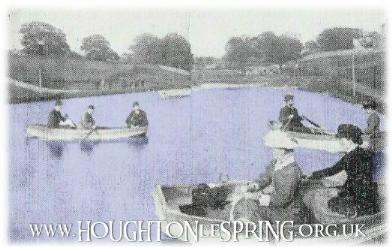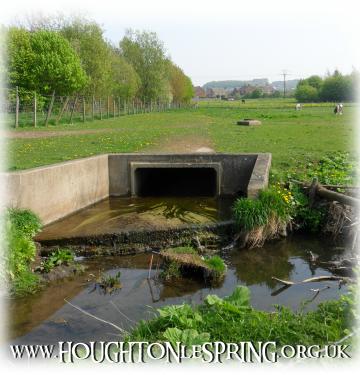[ YOU ARE HERE: Houghton Heritage > Articles > Leisure & Entertainment > The Lake ]
![]()
[ YOU ARE HERE: Houghton Heritage > Articles > Leisure & Entertainment > The Lake ]

The original Saxon village of Houghton is thought to have stood in the area now known as the Market Place, to the east of the town centre and bordering Houghton Moors and Kirklea. Copyright © Books of the North 2000 - 2011.
 |
SAXON WATER SOURCE
|
VICTORIAN PLEASURE BOATING
In 1881, local man Joseph Coulson, who lived in Stocksfield Place off of Sunderland Street, had a strip of land between Sunderland Street and the Market Place excavated. The burn was diverted and the area became an artificial boating lake, forever to be known as The Lake.
The attraction was very popular, particularly in the summer months, but it was not to everyone’s favour. The owners of Flint Mill, which was located between Sedgeletch and Grasswell, were deprived of their water source, and without the flowing waters were unable to turn the millwheel to crush flint for use in the potteries at Newbottle.
Litigation followed by the owners of the Mill.Copyright © Books of the North 2000 - 2011.
Shortly afterwards the Lake was filled in by two Darlington showmen, the Richardson Brothers, and the ground was used for visiting fairs and circuses. Always known as the Lake, many older Houghtonians will remember visiting the Lake Fairground during the annual Houghton Feast. Copyright © Books of the North 2000 - 2011.
Houghton Burn was culverted in the 1930s and the Lake ground became a bus station during the redevelopments of 1967. As compensation to the showmen who used the site during Houghton Feast, a piece of land at Grasswell was offered as a winter ground for their living wagons, while the Houghton Feast fairground was relocated to the Rectory Field on Dairy Lane. Copyright © Books of the North 2000 - 2011.
Houghton Enterprise Centre and the aptly named Lake Road (B1404) can be found on the site of the original boating lake, while the diverted Houghton burn disappears underground nearby. Sadly this area is strewn with litter and rubbish but is, surprisingly, home to many a wild bird.
An early map from December 1853 of the elevation of springs of water in Houghton-le-Spring shows that the culverted burn passes underneath the White Lion PH, before continuing in alignment along Burn Promenade. The cellar of the nearby Golden Lion pub is still susceptible from flooding during heavy rain.
The burn exits the culvert in an area west of Burnside Avenue, not far from where Flint Mill stood, as a tributary of Moors Burn.

If you have enjoyed this article and would like to make a donation to Houghton-le-Spring Heritage Society, please click DONATE for PayPal or to have your name recorded in the Book of Benefactors & Supporters click BOOK:
:: Darlington Local Studies

:: Map of the Town of Houghton-le-Spring in the Co of Durham, Public Health Act, December 1853
:: Local Records or Historical Register of Remarkable Events by John Sykes, 1833
:: London Era newspaper of September and October 1896 for confirming the surname of the showmen who filled the lake in as Richardson Bros of Darlington when it was long thought that it was the Robinson Bros (as suggested by K.Richardson).
[ YOU ARE HERE: Houghton Heritage > Articles > Leisure & Entertainment > The Lake ]
PAGE UPDATED: 21/12/2011